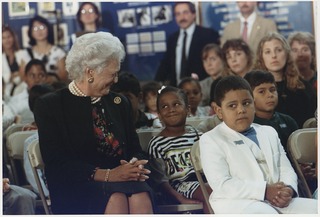
Phonics is a method for teaching people how to read and write an alphabetic language. It is done by demonstrating the relationship between the sounds of the spoken language (phonemes), and the letters or groups of letters (graphemes) or syllables of the written language. In English, this is also known as the alphabetic principle or the alphabetic code.

Scholastic Corporation is an American multinational publishing, education, and media company that publishes and distributes books, comics, and educational materials for schools, teachers, parents, children, and educational institutions. Products are distributed via retail and online sales and through schools via reading clubs and book fairs. Clifford the Big Red Dog, a character created by Norman Bridwell in 1963, serves as Scholastic's official mascot. Scholastic’s side project, Home Base, is still currently running, but it is unclear if Scholastic is still up keeping it.
Principles and Standards for School Mathematics (PSSM) are guidelines produced by the National Council of Teachers of Mathematics (NCTM) in 2000, setting forth recommendations for mathematics educators. They form a national vision for preschool through twelfth grade mathematics education in the US and Canada. It is the primary model for standards-based mathematics.
BrainPop is a group of children's educational websites based in New York City. It hosts over 1,000 short animated movies for students in grades K–12, together with quizzes and related materials, covering the subjects of science, social studies, English, math, engineering and technology, health, arts and music. In 2022, Kirkbi A/S, the private investment and holding company that owns a controlling stake in Lego, acquired BrainPop.

Weekly Reader was a weekly educational classroom magazine designed for children. It began in 1928 as My Weekly Reader. Editions covered curriculum themes in the younger grade levels and news-based, current events and curriculum themed-issues in older grade levels. The publishing company also created workbooks, literacy centers, and picture books for younger grades.
Accelerated Reader is a website used to assist students with reading skills. It is a digital program that helps students and teachers manage and monitor independent reading practice in both English and Spanish. Students pick a book at their own level and read it at their own pace. When students finish the book, they take a short quiz on the computer to check their understanding. As students read and take quizzes, they earn amount of points depending how thick the book is; the more thin the book is, the less words it gives them. It also tracks the students' progress toward their individualized Accelerated Reader goals.
Guided reading is "small-group reading instruction designed to provide differentiated teaching that supports students in developing reading proficiency". The small group model allows students to be taught in a way that is intended to be more focused on their specific needs, accelerating their progress.
Adolescent literacy refers to the ability of adolescents to read and write. Adolescence is a period of rapid psychological and neurological development, during which children develop morally, cognitively, and socially. All of these three types of development have influence—to varying degrees—on the development of literacy skills.
Shared reading is an instructional approach in which the teacher explicitly models the strategies and skills of proficient readers.
Eklavya is an Indian NGO based in Bhopal, Madhya Pradesh working in the field of education. It was registered as an all India in 1982. The organization is named after Eklavya, the protagonist of a story in the Mahabharat, for his determination to learn even in the absence of a teacher.
The learning center strategy uses eight basic learning centers to address the countless objectives of American early childhood classrooms, attempting to develop the student’s social, emotional, physical, cognitive, and aesthetic abilities.

Literacy in the United States was categorized by the National Center for Education Statistics into different literacy levels, with 92% of American adults having at least "Level 1" literacy in 2019. Nationally, over 20% of adult Americans have a literacy proficiency at or below Level 1. Adults in this range have difficulty using or understanding print materials. Those on the higher end of this category can perform simple tasks based on the information they read, but adults below Level 1 may only understand very basic vocabulary or be functionally illiterate. According to a 2020 report by the U.S. Department of Education, 54% of adults in the United States have English prose literacy below the 6th-grade level.

Reading is the process of taking in the sense or meaning of letters, symbols, etc., especially by sight or touch.
The New York Times Upfront is a news magazine for high school students, published by Scholastic Inc. in partnership with The New York Times. The magazine and its website feature journalism from the Times, as well as material produced by Upfront’s editorial staff.
Susan Neuman is an educator, researcher, and education policy-maker in early childhood and literacy development. In 2013, she became Professor of Early Childhood and Literacy Education, and Chair of the Department of Teaching and Learning at NYU's Steinhardt School of Culture, Education, and Human Development.
Nell K. Duke is a contemporary educator and literacy researcher with an interest in informational text, early literacy development, and reading comprehension instruction, with an emphasis on children living in poverty. She is currently a professor of language, literacy, and culture and a faculty associate in the combined program in education and psychology at the University of Michigan.
The Lexile Framework for Reading is an educational tool that uses a measure called a Lexile to match readers with books, articles and other leveled reading resources. Readers and books are assigned a score on the Lexile scale, in which lower scores reflect easier readability for books and lower reading ability for readers. The Lexile framework uses quantitative methods, based on individual words and sentence lengths, rather than qualitative analysis of content to produce scores. Accordingly, the scores for texts do not reflect factors such as multiple levels of meaning or maturity of themes. Hence, the United States Common Core State Standards recommend the use of alternative, qualitative methods for selecting books for students at grade 6 and over. In the US, Lexile measures are reported from reading programs and assessments annually. Thus, about half of U.S. students in grades 3rd through 12th receive a Lexile measure each year. In addition to being used in schools in all 50 states, Lexile measures are also used outside of the United States.

Differentiated instruction and assessment, also known as differentiated learning or, in education, simply, differentiation, is a framework or philosophy for effective teaching that involves providing all students within their diverse classroom community of learners a range of different avenues for understanding new information in terms of: acquiring content; processing, constructing, or making sense of ideas; and developing teaching materials and assessment measures so that all students within a classroom can learn effectively, regardless of differences in their ability.Differentiated instruction means using different tools, content, and due process in order to successfully reach all individuals. Differentiated instruction, according to Carol Ann Tomlinson, is the process of "ensuring that what a student learns, how he or she learns it, and how the student demonstrates what he or she has learned is a match for that student's readiness level, interests, and preferred mode of learning." According to Boelens et al. (2018), differentiation can be on two different levels: the administration level and the classroom level. The administration level takes the socioeconomic status and gender of students into consideration. At the classroom level, differentiation revolves around content, processing, product, and effects. On the content level, teachers adapt what they are teaching to meet the needs of students. This can mean making content more challenging or simplified for students based on their levels. The process of learning can be differentiated as well. Teachers may choose to teach individually at a time, assign problems to small groups, partners or the whole group depending on the needs of the students. By differentiating product, teachers decide how students will present what they have learned. This may take the form of videos, graphic organizers, photo presentations, writing, and oral presentations. All these take place in a safe classroom environment where students feel respected and valued—effects.
READ 180 is a reading intervention program, utilizing adaptive technology, in wide use by students in Grades 4–12 who read at least two years below grade level. It was created by Scholastic Corporation.

In the United States, elementary schools are the main point of delivery of primary education, for children between the ages of 5–11 and coming between pre-kindergarten and secondary education.







